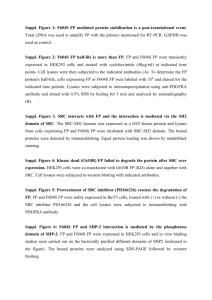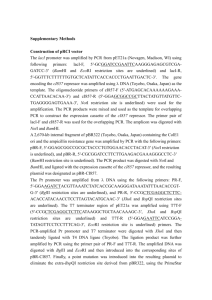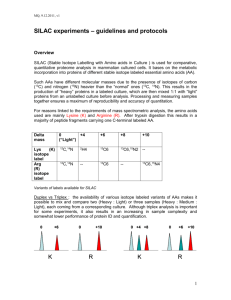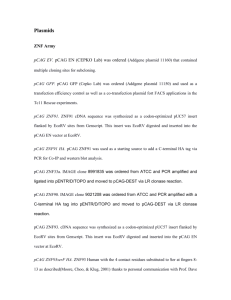hep26671-sup-0001-suppinfo01
advertisement
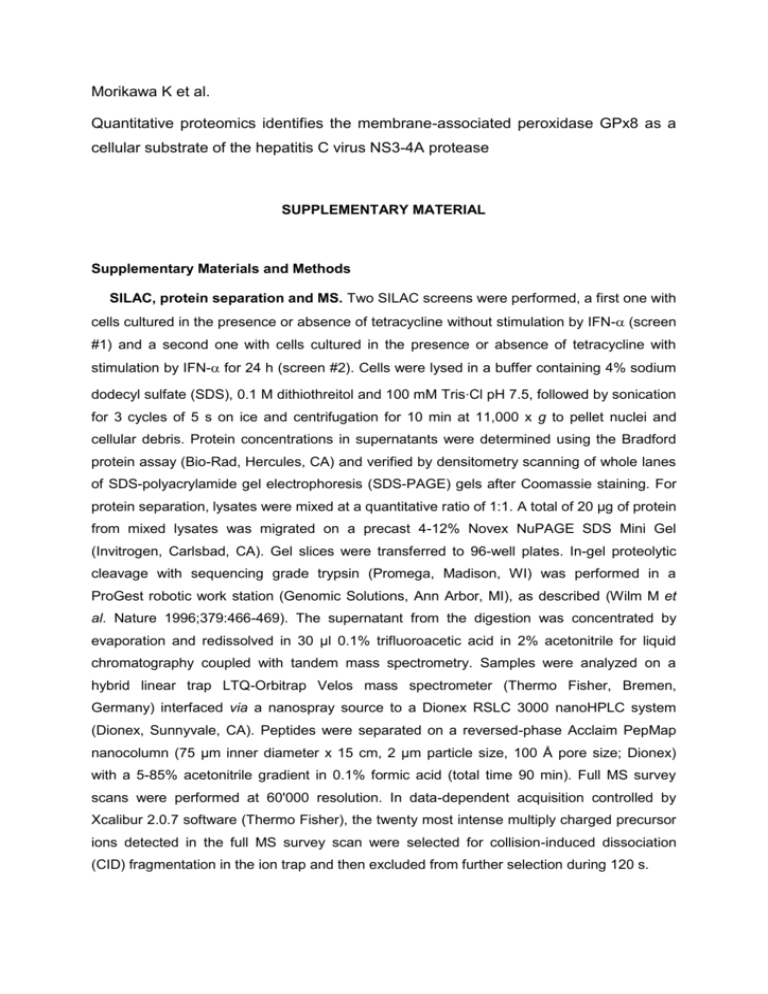
Morikawa K et al. Quantitative proteomics identifies the membrane-associated peroxidase GPx8 as a cellular substrate of the hepatitis C virus NS3-4A protease SUPPLEMENTARY MATERIAL Supplementary Materials and Methods SILAC, protein separation and MS. Two SILAC screens were performed, a first one with cells cultured in the presence or absence of tetracycline without stimulation by IFN- (screen #1) and a second one with cells cultured in the presence or absence of tetracycline with stimulation by IFN- for 24 h (screen #2). Cells were lysed in a buffer containing 4% sodium dodecyl sulfate (SDS), 0.1 M dithiothreitol and 100 mM Tris.Cl pH 7.5, followed by sonication for 3 cycles of 5 s on ice and centrifugation for 10 min at 11,000 x g to pellet nuclei and cellular debris. Protein concentrations in supernatants were determined using the Bradford protein assay (Bio-Rad, Hercules, CA) and verified by densitometry scanning of whole lanes of SDS-polyacrylamide gel electrophoresis (SDS-PAGE) gels after Coomassie staining. For protein separation, lysates were mixed at a quantitative ratio of 1:1. A total of 20 μg of protein from mixed lysates was migrated on a precast 4-12% Novex NuPAGE SDS Mini Gel (Invitrogen, Carlsbad, CA). Gel slices were transferred to 96-well plates. In-gel proteolytic cleavage with sequencing grade trypsin (Promega, Madison, WI) was performed in a ProGest robotic work station (Genomic Solutions, Ann Arbor, MI), as described (Wilm M et al. Nature 1996;379:466-469). The supernatant from the digestion was concentrated by evaporation and redissolved in 30 μl 0.1% trifluoroacetic acid in 2% acetonitrile for liquid chromatography coupled with tandem mass spectrometry. Samples were analyzed on a hybrid linear trap LTQ-Orbitrap Velos mass spectrometer (Thermo Fisher, Bremen, Germany) interfaced via a nanospray source to a Dionex RSLC 3000 nanoHPLC system (Dionex, Sunnyvale, CA). Peptides were separated on a reversed-phase Acclaim PepMap nanocolumn (75 μm inner diameter x 15 cm, 2 μm particle size, 100 Å pore size; Dionex) with a 5-85% acetonitrile gradient in 0.1% formic acid (total time 90 min). Full MS survey scans were performed at 60'000 resolution. In data-dependent acquisition controlled by Xcalibur 2.0.7 software (Thermo Fisher), the twenty most intense multiply charged precursor ions detected in the full MS survey scan were selected for collision-induced dissociation (CID) fragmentation in the ion trap and then excluded from further selection during 120 s. MS data analysis. MS data were analyzed and quantified using MaxQuant version 1.0.13.13 (Cox J and Mann M. Nat Biotechnol 2008;26:1367-1372), combined with Mascot version 2.3 (Matrix Science, London, UK). Database searches were performed on the IPI database (human subset) version 3.52 containing 55303 sequences and supplemented with reversed sequences and common contaminants, as described (Cox J and Mann M. Nat Biotechnol 2008;26:1367-1372). Search parameters were trypsin specificity, two possible missed cleavages and mass error tolerances of 7 ppm for the precursor and 0.5 Da for CID tandem mass spectra. The iodoacetamide derivative of cysteine was specified as a fixed modification, and oxidation of methionine and protein N-terminal acetylation were specified as variable modifications. Protein identifications were filtered at 1% false discovery rate established against a reversed database, according to default MaxQuant parameters. A minimum of one unique peptide was necessary to discriminate sequences which shared peptides. Sets of protein sequences which could not be discriminated based on identified peptides were listed together as protein groups. MaxQuant analysis used an experimental design file in which every dataset corresponding to a gel slice was quantified separately as a distinct experiment, numbered as the gel slice it corresponded to. Results from MaxQuant were filtered and processed further with custom-built software tools. The first was a Perl script that filtered the main MaxQuant result table “ProteinGroups.txt” to identify proteins present in at least two distinct gel slices with different SILAC ratios and a certain number of evidence counts, as described in the Results section. Next, the evidence counts and normalized SILAC ratios for these selected proteins were visualized as a function of the gel slice with an R script. The size and color of the circles were scaled to represent the number of evidences found and the log2 of the normalized SILAC ratios, respectively (Supplementary Figure 1). These Perl and R scripts are available from the authors upon request. Plasmids and recombinant viruses. cDNA was prepared by oligo-dT priming from total cellular RNA isolated from U-2 OS cells, followed by PCR using primers GPx8fwd1 and GPx8rev1 (Suppl. Table 1), and cloning into pCR®-BluntII-TOPO (Invitrogen), yielding pCRGPx8. Of note, the sequence of the GPx8 cDNA cloned in this study was identical to the one deposited in GenBank (accession number AAH29424). The GPx8 cDNA was retrieved from pCRGPx8 by PCR using primers FLAG-GPx8fwd and FLAG-GPx8rev (Suppl. Table 1), followed by digestion of the amplification product with BspEI and BamHI, and insertion into the BspEI/BamHI sites of pcDNA3.1(+) derivatives allowing the fusion with either an N- or a C-terminal FLAG tag (J.G. and D.M., unpublished data), yielding plasmids pCMVGPx8-FLAG and pCMVFLAG-GPx8, respectively. Mutation of Cys 11 to Ala (C11A) in GPx8 was achieved by using the QuickChangeTM Site-Directed Mutagenesis Kit (Strategene, La Jolla, CA), pCMVGPx8-FLAG as template, and primers GPx8-C11Afwd and GPx8-C11Arev 2 (Suppl. Table 1), yielding pCMVGPx8C11A-FLAG. An N-terminally truncated sequence coding for GPx8 amino acids 12-209 was amplified from pCRGPx8 using primers GPx8-S12fwd and FLAG-GPx8rev (Suppl. Table 1), followed by digestion with BspEI and BamHI, and insertion into the BspEI/BamHI sites of the pcDNA3.1(+) derivative allowing the fusion with a Cterminal FLAG tag, yielding pCMVGPx8S12-FLAG. For production of a GPx8-glutathione S-transferase fusion protein in E. coli, the cDNA encoding GPx8 amino acids 38-209 was amplified from pCRGPx8 using primers GPx838fwd and GPx8rev2 (Suppl. Table 1), followed by digestion with EcoRI and NotI, and insertion into the EcoRI/NotI sites of pGEX-6P-1 (GE Healthcare, Buckinghamshire, UK), yielding pGEX-GPx8[38-209]. For production of a recombinant retrovirus, the GPx8 cDNA was amplified from pCRGPx8 using primers GPx8fwd2 and GPx8rev2, followed by digestion with EcoRI and NotI, and insertion into the EcoRI/NotI sites of pLPCX (Clontech, Mountain View, CA), yielding pLPCXGPx8. Substitution of GPx8 Cys 11 by Ala (C11A) was achieved by using the QuickChangeTM Site-Directed Mutagenesis Kit (Strategene), pLPCXGPx8 as template, and primers GPx8-C11Afwd and GPx8-C11Arev (Suppl. Table 1), yielding pLPCXGPx8C11A. The GPx8S12 cDNA was amplified from pCRGPx8 using primers GPx8-S12fwd2 and GPx8rev2, followed by digestion with EcoRI and NotI, and insertion into the EcoRI/NotI sites of pLPCX, yielding pLPCX GPx8S12. Substitution of GPx8 Cys 79 by Thr (C79T) in GPx8 was achieved by using the QuickChangeTM Site-Directed Mutagenesis Kit (Strategene), pLPCXGPx8 as template, and primers GPx8-C79Tfwd and GPx8-C79Trev (Suppl. Table 1), yielding pLPCXGPx8C79T. pLPCXeGFP as well as packaging constructs pMLV-NB and pMD.G, encoding Gag, Pol and VSV glycoproteins, respectively, were kindly provided by Angela Ciuffi (University of Lausanne, Switzerland) and Didier Trono (Ecole Polytechnique Fédérale de Lausanne, Switzerland). Fidelity of all PCR products was confirmed by sequencing. Immunofluorescence. Immunofluorescence staining was performed as described (Moradpour D et al. Virology 1996;222:51-63). Images were acquired by an SP5 Leica confocal laser scanning microscope and processed with ImageJ software. 3 Supplementary Table 1. Oligonucleotide sequences. Name Restr. site Sequence1 GPx8fwd1 5' TCCAGGCTGCTGAGACTTCCCT 3' GPx8rev1 5' TGAGACCAAACCCTCATGGAGACA 3' FLAG-GPx8fwd BspEI 5' ATGATGTCCGGAGAGCCTCTTGCAGCTTACCC3' FLAG-GPx8rev BamHI 5' ATGATGGGATCCTAGATCCTCTTTCTTTTTTA 3' GPx8-C11Afwd 5' CCTCTTGCAGCTTACCCGCTAAAAGCTTCCGGGCCCAGA 3' GPx8-C11Arev 5' AAATACCTTTGCTCTGGGCCCGGAAGCTTTTAGCGGGTA 3' GPx8-S12fwd BspEI 5' ATGATGTCCGGATCCGGGCCCAGAGCAAAGGT 3' GPx8-38fwd EcoRI 5' ATGATGGAATTCAAATTCCTCAAACCTAAAAT 3' GPx8-C79Tfwd 5’ AACGTGGCCAGTGACACCCAACTCACAGACAGAAA 3’ GPx8-C79Trev 5’ TCTGTCTGTGAGTTGGGTGTCACTGGCCACGTTTA 3’ GPx8rev2 NotI 5' ATGATGGCGGCCGCTCATAGATCCTCTTTCTTTTTTA 3' GPx8fwd2 EcoRI 5' ATGATGGAATCCGCCACCATGGAGCCTCTTGCAGCTTACCC 3' GPx8-S12fwd2 EcoRI 5’ ATGATGGAATTCGCCACCATGTCCGGGCCCAGAGCAAAGGT 3’ 1 Restriction enzyme recognition sites are underlined and mutated nucleotides are shown in bold. 4 Supplementary Table 2. SILAC results for GPx8 and previously described cellular targets of the HCV NS3-4A protease. SILAC screen #1 (UNS3-4A-24 + tet vs. - tet) Slice* SILAC ratio Peptide (protease/control) count# SILAC screen #2 (UNS3-4A-24 + tet vs. - tet, + IFN-) Slice* SILAC ratio Peptide (protease/control) count# GPx8 44 45 46 0.11 50.00 9.09 5 4 1 42 43 44 0.09 23.21 10.99 11 6 2 MAVS nd - - 23 24 0.03 6.36 2 1 DDB1 12 13 0.68 1.12 1 21 13 14 15 0.97 1.96 0.73 59 43 1 TRIF TC-PTP nd nd - - nd nd - - *Slice numbers were counted from the top of the gel. #Number of quantified peptide identifications. nd, not detected. 5 Legends to Supplementary Figures Supplementary Figure 1. Virtual electropherogram with quantitative values produced by "slice-SILAC". A representative subset of the data from the screen #1 (without IFN- stimulation) is shown, including GPx8 (Suppl. Table 2). Only proteins found in at least two gel slices with diverging heavy-over-light (H/L) ratios were prefiltered and are represented here. Only the region below a molecular weight of 50 kDa is shown for ease of representation. Bubble diameters are proportional to the number of quantified peptide matches, while the gradient color represents the H/L ratio, as indicated in the legend. GPx8 is highlighted in yellow. A representative gene name for every protein group is given at the bottom (standard abbreviations as used, e.g., in the Swiss-Prot database). Of note, histone proteins H3F3A and HIST2H2AA3 showed shifts to lower molecular weight upon NS3-4A expression. However, given their broad distribution and known high degree of modification these were not further investigated. Rab13 appeared as a potential candidate (although at less significant H/L ratios) but was not found to be a NS3-4A protease substrate in the subsequent experimental validation process. Supplementary Figure 2. Cell lysates subjected to protein separation and mass spectrometry. A portion of the lysates from the heavy (H) or light (L) isotope-labeled UNS34A-24 cells subjected to protein separation and mass spectrometry in the present study was analyzed by immunoblot using monoclonal antibody (mAb) 1B6 against NS3 (Wölk B et al. J Virol 2000;74:2293-2304), mAb Adri-1 against MAVS (Adipogen, Epalinges, Switzerland), polyclonal antibody E23 against Stat1 p84/p91 (Santa Cruz, Santa Cruz, CA) or mAb AC-15 against -actin (Sigma-Aldrich, St. Louis, MO) (lanes 3-6). Lysates from naïve Huh-7.5 cells and Huh-7.5 cells harboring a subgenomic HCV Con1 (sg1b, genotype 1b) replicon were included as reference (lanes 1 and 2). A total of 10 µg protein was loaded in each lane. aa, amino acid; IFN-, interferon-; tet, tetracycline. Supplementary Figure 3. Basis for the three-dimensional model of the N-terminal cytosolic tip and the transmembrane segment of GPx8 illustrated in Figure 2C. Similarity of the GPx8 N-terminal sequence to the sequence of amino acids 155-171 of filamin A immunoglobulin-like repeat 10 (PDB entry 3RGH; Page RC et al. Acta Crystallogr Sect F Struct Biol Cryst Commun 2011;67:871-876) (top row) and to the transmembrane -helix 2041 of FXYD protein of the sodium-potassium ATPase (PDB entry 2ZXE, chain G; Shinoda T et al. Nature 2009;459:446-450) (middle row). The degree of amino acid physicochemical 6 conservation at each position relatively to GPx8 sequence is indicated with the similarity index according to ClustalW convention (asterisk, invariant; colon, highly similar; dot, similar; Thompson JD et al. Nucleic Acids Res 1994;22:4673-4680). The GPx8 sequence displays 71% similarity (47% identity) within the 17 amino acid overlap for the 3RGH sequence, and 89% similarity (26% identity) with the 19 amino acid overlap for the 2ZXE sequence. “Struct.” represents the secondary structure of the different protein segments deduced from the corresponding three-dimensional structures: h, helix; s, bend; t, hydrogen-bonded turn. The beginning of the X-ray structure of GPx8 luminal domain is also indicated (PDB entry 3KIJ; Nguyen VD et al. J Mol Biol 2011;406:503-515; bottom row). #, GPx8 transmembrane segment predicted by algorithms PHDhtm (http://www.predictprotein.org/), TMHMM (http://www.cbs.dtu.dk/services/TMHMM), TopPred2 DAS (http://www.sbc.su.se/miklos/DAS/), (http://mobyle.pasteur.fr/cgi-bin/MobylePortal/portal.py?form_toppred), (http://www.ch.embnet.org/software/TMPRED_form.html), Tmpred HMMTOP (http://www.enzim.hu/hmmtop/), and SOSUI (http://bp.nuap.nagoya-u.ac.jp/sosui/). Supplementary Figure 4. siRNA-mediated silencing of GPx8. Huh-7.5 cells overexpressing GPx8 (Huh-7.5-GPx8) were transfected with GPx8 siRNAs #1 or #2 or a non-targeting control, as described in the Materials and Methods section. Cell lysates obtained 96 h later were analyzed by 15% SDS-PAGE and immunoblot using polyclonal antibody IN103 against GPx8. A total of 10 µg protein was loaded in each lane. Supplementary Figure 5. Subcellular localization of GPx8 and mutants. Huh-7.5 cells transduced with recombinant viruses expressing GPx8, GPx8C11A, GPx8S12 and GPx8C79T were infected with Jc1 HCVcc and stained 48 h later with polyclonal antibody IN103 against GPx8 and monoclonal antibody #337 against HCV NS3 (kindly provided by Thomas Pietschmann, Twincore, Hannover, Germany) as well as Alexa Fluor® 488- and 594conjugated secondary antibodies (Life Technologies), respectively. Nuclei were stained with DAPI (AppliChem). Representative confocal laser scanning microscopy images are shown for each construct. GPx8 (green) and NS3 (red) are shown separately and as merged images including the DAPI staining (blue). An inset is shown at higher magnification for GPx8-transduced cells. GPx8 is mostly expressed at the ER membrane including the perinuclear membrane and partially colocalizes with HCV NS3. No appreciable difference is observed in the subcellular localization of GPx8 and the different GPx8 mutants. 7
